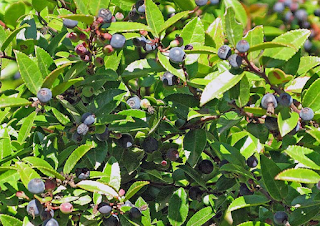 |
| Saskatoon [Meggar/WikiMedia] |
Saskatoon Amelanchier alnifolia
Saskatoon berries were highly regarded by all indigenous groups. They were dried into cakes for storage. Horticulturalists have developed several varieties for commercial and garden use. The berries provide important winter browse for ungulates and many wild bird species feast on the berries in late summer. (Plants of the Pacific Northwest Coast)
After 4 years of study, feds finally decide whether to tear down Snake River dams
Federal agencies have adopted the conclusions of a four-year-long environmental study that rejected calls to tear down the four lower Snake River dams. Instead, more water will be spilled over dams each spring in the Columbia River hydrosystem, which includes Snake River dams, to help juvenile fish heading downstream, as outlined in the management alternative that was ranked highest in the study. The decision to adopt the alternative was made by the Army Corps of Engineers, Bureau of Reclamation and Bonneville Power Administration, which were in charge of the study. Annette Cary reports. (TriCity Herald)
Navy expands testing of water after wells near Bangor base found with contamination
Two wells bordering Naval Base Kitsap's southern edge have been found to have potentially harmful levels of contamination caused by a firefighting foam long used on the base, and the Navy is pursuing further testing to examine a wider area for its presence this fall. The results come from an initial round of water testing earlier this year for what are known as perfluoroalkyl and polyfluoroalkyl substances, commonly known by their acronym, PFAS...Of the 292 wells sampled by the Navy in February, 83 showed some level of PFAS, the Navy said. Josh Farley reports. (Kitsap Sun)
Three more Asian giant hornets found in Whatcom. Why the warm weather could mean more
There are three new confirmed sightings of Asian giant hornets in Whatcom County, increasing to 12 the number that have been reported here. The total represent the first sightings of the hornets in Washington state and the U.S. since they were first spotted in Whatcom in 2019. All three recent sightings were found near Burk Road, southeast of Blaine, in late September, according to the Washington State Department of Agriculture. Kie Relyea reports. (Bellingham Herald)
Secret Recordings Portray Regulators as Easing Pebble Mine’s Path to Approval
As the US Army Corps of Engineers (USACE) weighs whether to approve the controversial Pebble Mine in Alaska, secret recordings of conversations between undercover activists and top executives from the Pebble Limited Partnership (PLP) are putting regulators and the developer under new scrutiny, including around the latest unconventional attempt to develop a compensatory mitigation plan to offset the damage the proposed mine would cause to the environment. Ashley Braun reports. (Hakai Magazine)
‘Super-Enzyme’ Speeds Up Breakdown of Plastic, Researchers Say
A new cocktail of enzymes that speeds up the degradation of plastic offers a step forward in finding a new form of recycling that is faster, is more affordable and works on a larger scale than current methods, British and American researchers said this week. The “super-enzyme” could be employed to break down plastic bottles much more quickly than current recycling methods and create the raw material to make new ones, according to the scientists. And it may make it easier to repurpose the material. Isabella Kwai reports. (NY Times)
Now, your tug weather--
West Entrance U.S. Waters Strait Of Juan De Fuca-
244 AM PDT Wed Sep 30 2020
TODAY
E wind to 10 kt becoming S in the afternoon. Wind waves
1 ft or less. W swell 4 ft at 11 seconds. Haze.
TONIGHT
W wind 5 to 15 kt becoming to 10 kt after midnight.
Wind waves 2 ft or less. W swell 4 ft at 11 seconds. Haze.
"Salish Sea News & Weather" is compiled as a community service by Mike Sato. To subscribe, send your name and email to msato (@) salishseacom.com. Your email information is never shared and you can unsubscribe at any time.
Salish Sea News: Communicate, Educate, Advocate
Follow on Twitter.
Salish Sea Communications: Truth Well Told











